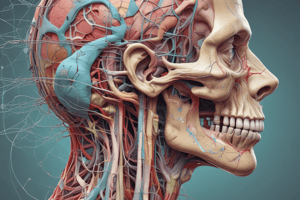Podcast
Questions and Answers
What was the initial method for reintroducing the hypoglossal nerve for facial reanimation?
What was the initial method for reintroducing the hypoglossal nerve for facial reanimation?
- Direct nerve grafting from the facial nerve
- Half-nerve segment manipulation for minimal dysfunction
- Interposition grafting with minimal nerve damage
- End-to-end neural coaptation after transection (correct)
What is a significant drawback of complete hypoglossal nerve transfer?
What is a significant drawback of complete hypoglossal nerve transfer?
- Insufficient reinnervation of facial muscles
- Inability to activate movement consciously
- Diminished speech clarity due to nerve damage
- Interference with normal tongue function (correct)
What outcome did interposition jump grafting show in terms of preserving tongue function?
What outcome did interposition jump grafting show in terms of preserving tongue function?
- Less than 50% preservation of tongue function
- Preservation of tongue function in 87% of patients (correct)
- An increase in tongue muscle flexibility post-operation
- Complete preservation in all patients
What recent approach involves using only a portion of the hypoglossal nerve?
What recent approach involves using only a portion of the hypoglossal nerve?
Which of the following is a potential issue with hypoglossal nerve transfer despite modifications to the technique?
Which of the following is a potential issue with hypoglossal nerve transfer despite modifications to the technique?
Flashcards
Hypoglossal nerve transfer for facial reanimation
Hypoglossal nerve transfer for facial reanimation
A surgical procedure that uses the hypoglossal nerve to reanimate paralyzed facial muscles.
Mini-hypoglossal transfer
Mini-hypoglossal transfer
A surgical procedure that uses only a portion of the hypoglossal nerve for facial reanimation, preserving tongue function.
Hemiglossal dysfunction
Hemiglossal dysfunction
A condition that results from the transfer of the hypoglossal nerve for facial reanimation, causing difficulties with speaking, swallowing, and chewing.
Conscious effort for facial movement
Conscious effort for facial movement
Signup and view all the flashcards
Facial spasm and mass movement
Facial spasm and mass movement
Signup and view all the flashcards
Study Notes
Hypoglossal Nerve for Facial Reanimation
- Hypoglossal nerve transfer for facial reanimation was first reported in 1901.
- Early procedures involved transecting the hypoglossal nerve for end-to-end connection with the facial nerve.
- This complete transfer was abandoned due to speech, swallowing, and mastication problems (hemi-glossal dysfunction).
- A modified technique avoids complete transfer by incising the hypoglossal nerve distal to the descendens hypoglossi and using a jump graft to connect it to the facial nerve. This approach preserves tongue function in 87% of patients.
- The more recent mini-hypoglossal transfer involves splitting the nerve longitudinally and using only the superior 40% section. This preserves more hypoglossal axons to minimize impact on tongue function.
Advantages and Disadvantages
- Advantages include the nerve's proximity to paralyzed facial muscles and the potential for dynamic movement.
- Activation requires conscious effort (not spontaneous).
- Possible complications include facial spasms and mass movements during tongue movements.
- Potential for functional deficits in the donor (tongue function) can still occur irrespective of modifications.
Studying That Suits You
Use AI to generate personalized quizzes and flashcards to suit your learning preferences.



